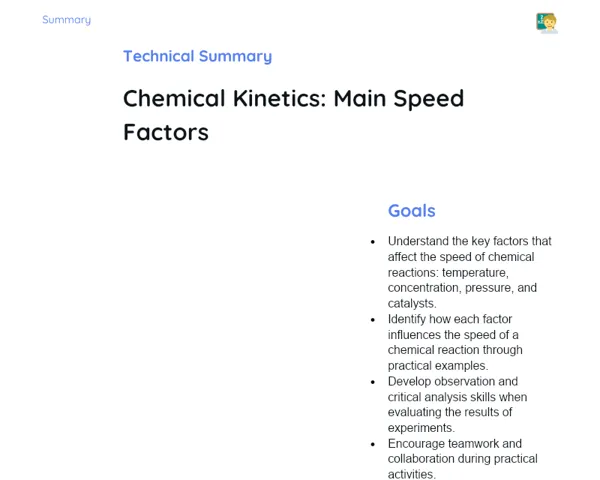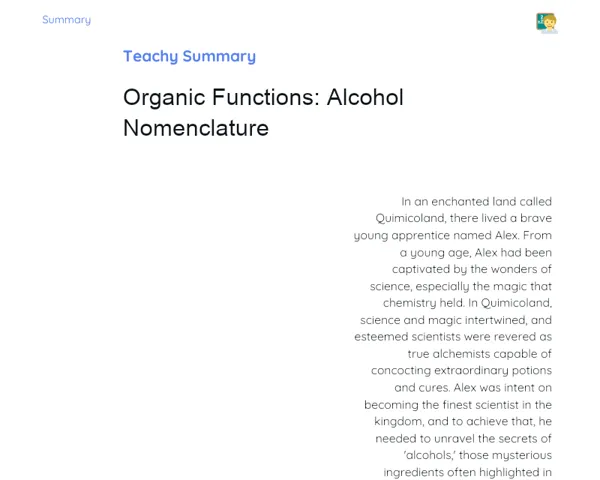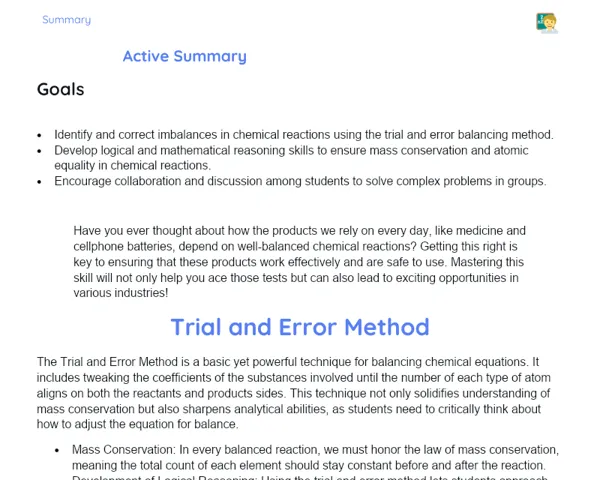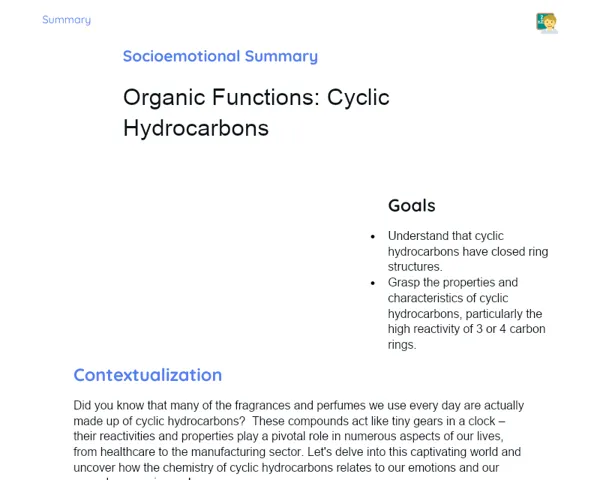Summary Tradisional | Chemical Kinetics: Main Speed Factors
Contextualization
Chemical kinetics is a branch of chemistry that examines how fast chemical reactions occur and what factors influence this speed. Gaining insight into chemical kinetics is essential in optimising processes across a range of industries, such as pharmaceuticals, food preservation, and even natural events. For instance, understanding how to accelerate or slow down a reaction can be critical in the manufacturing of medicines or in preventing food from going off.
The rate at which chemical reactions happen can differ dramatically. Some reactions take place almost instantaneously, like a firecracker going off, while others can stretch over years, such as rust forming on iron. Factors including temperature, the concentration of reactants, pressure, and the presence of catalysts all play crucial roles in determining this speed. By comprehending how each factor functions, we can predict chemical reactions' behavior and manipulate them according to our needs in various situations.
To Remember!
Temperature
Temperature is a vital factor affecting how quickly chemical reactions occur. Generally, raising the temperature boosts the kinetic energy of the molecules involved. This means they move faster and collide more often and forcefully. As a result, more frequent and vigorous collisions increase the chances of the molecules overcoming the activation energy barrier essential for the reaction to kick off.
When the temperature goes up, the energy distribution among the molecules widens. This implies a greater proportion of molecules possess enough energy to overcome the activation energy threshold. In practical terms, this can greatly speed up a reaction. For example, the breakdown of hydrogen peroxide (H2O2) happens quicker at elevated temperatures.
Conversely, reducing the temperature causes a slowdown. Molecules move lethargically, resulting in fewer collisions and lower energy in each interaction. This diminishes the likelihood of the reaction taking place, thus slowing the reaction speed. This idea is applied in food preservation, where lower temperatures are used to stall decomposition reactions.
-
An increase in temperature raises the kinetic energy of molecules.
-
Higher frequency and energy of collisions among molecules.
-
Wider energy distribution at higher temperatures.
Concentration
The concentration of the reactants is another crucial factor in determining the pace of a chemical reaction. The Rate Law suggests that the speed of a reaction is directly proportional to the concentration of its reactants. When the concentration is higher, there’s a greater likelihood of molecular collisions, leading to more effective collisions in a given timeframe.
For instance, when hydrochloric acid (HCl) interacts with magnesium (Mg), raising the concentration of HCl results in a quicker release of hydrogen gas (H2). This happens because there are more HCl molecules ready to collide with the magnesium ones, boosting the chances of a successful reaction.
In practical scenarios, managing the concentration of reactants is vital. In the chemical industry, tweaking the concentration can enhance the pace and efficiency of reactions, aiding in cost reduction and improving output. In labs, adjusting the concentrations is commonly practised to investigate reaction kinetics and understand various mechanisms at play.
-
The reaction speed is proportional to the concentration of reactants.
-
Higher concentration results in a greater number of molecular collisions.
-
Controlling concentration is crucial in both industrial and laboratory settings.
Pressure
Pressure is another factor influencing the speed of chemical reactions, particularly those involving gases. When the pressure in a gas system is increased, the concentration of gas molecules rises as they are compressed into a tighter space. This heightens the frequency of molecular collisions, potentially speeding up the reaction.
A classic illustration is the ammonia synthesis via the Haber process, where nitrogen (N2) and hydrogen (H2) react under high pressure to yield ammonia (NH3). Increasing the pressure promotes the formation of ammonia, enhancing both the reaction speed and efficiency of the process. This principle is extensively applied in industries aiming to maximise chemical production and minimise reaction times.
In contrast, lowering the pressure reduces collision frequency, which in turn slows down the reaction. For reactions where pressure is a key factor, keeping a precise control over this variable is critical to achieving desired outcomes.
-
An increase in pressure raises the concentration of gas molecules.
-
Higher frequencies of molecular collisions under elevated pressure.
-
High pressure is employed to optimise industrial reactions, like in the Haber process.
Catalysts
Catalysts are substances that speed up chemical reactions without being consumed in the process. They provide an alternative pathway for reactions that require less activation energy. This means more reactant molecules will have the necessary energy to engage, thus increasing the reaction speed.
Catalysts can either be homogeneous—when they exist in the same phase as the reactants—or heterogeneous—when they’re in a different phase. A typical example of a homogeneous catalyst is the enzyme catalase, which hastens the breakdown of hydrogen peroxide into water and oxygen. An example of a heterogeneous catalyst would be platinum, used in vehicle catalytic converters to transform harmful gases into less dangerous substances.
The role of catalysts is pivotal in various sectors, including pharmaceuticals, where they can hasten drug production, and petrochemicals, where they're used to simplify large hydrocarbon molecules into smaller, more useful products. Their efficiency paves the way for speedier and more cost-effective processes, while also mitigating the need for extreme temperatures and pressures.
-
Catalysts enhance reaction speed without getting used up.
-
They offer an alternative pathway that requires lower activation energy.
-
Critical in pharmaceutical and petrochemical industries for more efficient production.
Key Terms
-
Chemical Kinetics: The study of the pace of chemical reactions and the factors influencing them.
-
Reaction Rate: The speed at which reactants transform into products.
-
Temperature: A measure of average kinetic energy in a substance, affecting reaction speed.
-
Concentration: The amount of a substance within a specific volume, impacting collision frequency.
-
Pressure: The force exerted by gas molecules within a volume, affecting gaseous reaction speed.
-
Catalyst: A substance that speeds up a reaction without being consumed, providing a lower energy alternative.
-
Activation Energy: The minimum energy necessary for a chemical reaction to take place.
-
Homogeneous Reaction: A reaction where the reactants and catalyst share the same phase.
-
Heterogeneous Reaction: A reaction where the reactants and catalyst exist in different phases.
Important Conclusions
In this lesson, we examined the main factors influencing the speed of chemical reactions: temperature, concentration, pressure, and catalysts. Each factor plays an essential role in determining how swiftly reactions occur, affecting everything from industrial practices to natural occurrences. Understanding these elements not only enhances our ability to predict reactions' behaviors but also empowers us to manipulate them for various applications.
Increasing temperature boosts molecular kinetic energy, leading to more effective collisions. Likewise, the concentration of reactants directly correlates with reaction speeds—higher concentrations equate to more molecular encounters. Pressure mainly influences gaseous reactions, where increasing pressure elevates the concentration of gaseous reactants. Catalysts create an alternative route for reactions, requiring less activation energy, thus speeding up processes without being depleted.
The knowledge gained from this lesson holds considerable relevance, from drug manufacturing in the pharmaceutical industry to food preservation techniques. Mastering how to control reaction speeds opens pathways for process optimisation, cost-reduction, and improved efficiency across different fields. We encourage learners to keep delving into this topic to expand their understanding and apply their knowledge in hands-on ways.
Study Tips
-
Go over the concepts of activation energy and their relation to temperature, concentration, pressure, and catalysts. Employ real-life examples to enhance comprehension.
-
Practice solving problems related to reaction rate calculations, adjusting different concentrations and temperature or pressure conditions.
-
Investigate the use of catalysts in various industries, such as pharmaceuticals and petrochemicals, to gain a better understanding of their significance and advantages.



